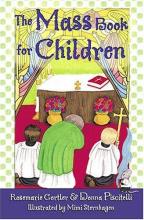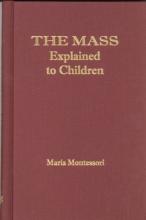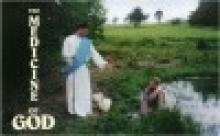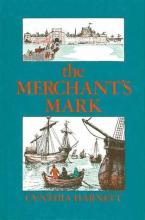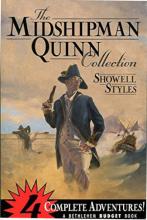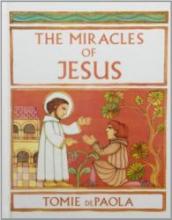No name
The Mass Book for Children
This little booklet is a colorfully illustrated and simply written explanation of what happens during the Mass and why. It is broken up into seven main sections: "The Mass Begins!", "The Introductory Rite", "The Penitential Rite", "The Liturgy of the Word", "The Profession of Faith", "The Liturgy of the Eucharist", and "The Concluding Rite". Rather than a missal for children, this is intended to be used outside of Church in preparation to understand the Mass better. (It would be particularly effective when used with the Miniature Mass Kit. Each page of text is highlighted with an appropriate quote from the Bible.
Here is a little sample:
(pg. 30, emphasis in original) This is a very child-friendly, orthodox introduction to the Holy Mass for young children - especially preschool through second grade.Everyone, get on your knees!
The consecration is about to happen!
This is the most solemn part of the Mass, so we pay close attention.
Father prays over the bread and wine and asks all the angels and saints to join us in our prayer to God.
Father asks the Holy Spirit to come and change this bread and wine into the Body and Blood of Jesus!
Watch carefully. Father takes the bread in his hands and, lifting it up to God, he uses Jesus' own words:
Take this, all of you, and eat it: this is my body which will be given up for you."
Father holds the bread become Jesus up very high, showing it to all of us.
At that moment, all the angels in heaven are rejoicing! We bow our heads and offer a prayer to our great God.
Imprimatur and Nihil Obstat
The Mass: Explained to Children
This book explains the meaning of the Mass, the significance of its parts and why it should be celebrated with such reverence. I was especially impressed with how the author portrays the sacredness of the Mass in ways that are meaningful to children. You and your children will learn about the sacred vessels and vestments, the liturgical colors and seasons, the meaning behind the various prayers and actions, etc.
A few practical notes - Because this book was written in 1932, it most precisely applies to the Tridentine Mass. However, it is an excellent study for those who attend the Novus Ordo Mass as well, and I think you'll see that the essentials remain unchanged when the Mass is properly said. My sister-in-law also assures me that the book is quite useful and applicable for those who belong to the Byzantine Rite. The book would most appropriately serve as a read-aloud, allowing for some discussion, questions and explanations along the way. It would be very suitable as an aid in preparing your child for First Communion, but is very informative for older children and adults as well.
The Medicine of God
45 minutes, audio cassette
The Merchant's Mark
The Merchant's Mark is a mystery set in England in 1493, against a rich historical background of a family involved in the wool industry. The author weaves much detail about the wool and cloth trades into the story. Many traditions, celebrations and religious practices are also included, giving the reader a very nice picture of life at that time - particularly their strong Catholic culture. This might be a good book to read alongside a study of Christopher Columbus. Not only does the story take place at the time of his voyage, but the information about the cloth trade is interesting because Columbus came from a cloth-making family.

Originally published in 1951 as The Wool Pack by Methuen in England, with illustrations by the author. The American Lerner edition retains these illustrations.
The Midshipman Quinn Collection
This collection includes all four stories (Midshipman Quinn, Quinn of the Fury, Midshipman Quinn and Denise the Spy, and Quinn at Trafalgar) of Midshipman Septimus Quinn, a junior officer of the British Navy from 1803-1805.
Septimus Quinn is a "small and studious" 15 year old who finds himself in the midst of all sorts of adventures fighting Napoleon under Lord Nelson. Daring naval assignments take him all over the Mediterranean as he really uses his head to deal with pirates, arrogant shipmates, runaway French patriots, clueless prison guards, etc. Complex escape plans, wild disguises and interesting sub-plots are par for the course. The reader will learn a great deal about ships and life at sea and the danger and excitement of sea battles amidst accounts of true historical events.The strategies of battle and other historical details are quite fascinating. The suspense and drama make it most appropriate for junior high and high school.
I found that it took me a little while to "get into" the story. I think this is because the continuous adventures and excitement make for a somewhat slower character development (READ: It will appeal to boys!). However, by the beginning of the second book, as I got to know Septimus Quinn a bit better, I was "hooked."
Copyrights 1956 - 1965. Bethlehem Books reprinted them in a single volume in 1999.
This book was donated for review by Bethlehem Books.
The Miracle of Our Lady of Fatima
This is a full length color movie of the story of Our Lady's apparitions to three children in Fatima, Portugal in 1917. It is faithful to the true story with just enough "Hollywood" to make it entertaining and likable even for the little ones. The scene where the three children are interrogated by the government officials might be is a little intense, so I wouldn't recommend having your little ones watch it without supervision. Otherwise, it's a great film for the whole family. My daughter (almost 6 years old) received this for Easter (Thank you Grandma! : ) and absolutely loved it. I was very impressed with how accurate the important aspects of the story are told. I especially love how they handled the miracle of the sun on October 13, 1917 and how they portray two of the miracles that occurred at the time.
The "jokester" character of Hugo is a Hollywood creation.
Update from webmaster, March 2024: The 2006 re-release is pictured here, and is available on DVD or streaming services.
The Miracle of St. Nicholas
The text is fully illustrated using the traditional icon technique and style. It makes for a charming, but slightly haunting look... a subtle reminder of past sorrows in the face of a hopeful future. The book is a delightful Christmas story for the whole family; full of faith, hope and the beauty of tradition.
The Miracle on 34th Street
The idea for the movie originated as the Davies family watched the Macy's Thanksgiving Day Parade from their apartment in post-WWII New York City. Mr. Davies remarked on the growing commercialism of the season and asked "What would Santa do if he were here today?" The answer was a classic movie from 20thCentury Fox. The book, The Miracle on 34th Street, is true to this original movie - written by Davies and his wife after the movie's debut, the book was an instant success. The copy we have, reprinted in 1998 by Galahad Books, is richly illustrated by Tomie de Paola.
This has been our lunch-time read-aloud since Advent began. The book stays very close to the movie but does have some slight differences - there is no young Alfred in this book, but Mr. Sawyer is just as rotten!
Reading this book aloud to my 3, 5, and 6 year-olds has helped me understand why I've always loved this story. Kris Kringle explains early on that "Christmas isn't just a day. It's a frame of mind." Towards the end of the book, Doris explains to her daughter that "faith is believing in things when common sense tells you not to... Anyone could have faith when everything was fine. But real faith meant believing, rain or shine." These two quotes are a summation of why Christmas is my absolute favorite holiday and why I don't mind my little ones believing in Santa Claus - he's the personification of the magic of the season and the mystery of Incarnate Word!
The Miracles of Jesus
This book is a beautiful way to help your children learn to know and love Jesus. With many simple pictures (but nicely done) and just enough details of the story, Tomie de Paola relates how Jesus helped others while he was on earth. Stories include: The Wedding at Cana, The Catch of Fishes, The Calming of the Storm, The Loaves and The Fishes, Jesus Walks on the Water, The Paralyzed Man, The Centurion's Servant, Jesus Heals the Lepers and The Raising of Lazarus. (13 stories altogether) My children love to hear about how good Jesus is and how much he loves them. This book is a really nice way of reinforcing that idea.

